 Or in your home? There’s been a recall on Kidde fire extinguishers. Learn more here, and then check to make sure you don’t have one that’s been recalled.
Or in your home? There’s been a recall on Kidde fire extinguishers. Learn more here, and then check to make sure you don’t have one that’s been recalled.
2017 Lifetime Achievement Award
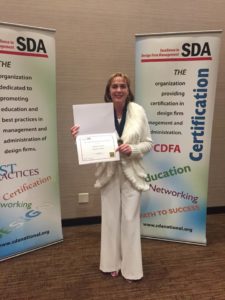 We’re sending a big shout-out to Melodee Schultz (of the Houston Chapter), who was honored with the 2017 Lifetime Achievement Award at the SDA EDSymposium17 banquet. Congratulations, Melodee!
We’re sending a big shout-out to Melodee Schultz (of the Houston Chapter), who was honored with the 2017 Lifetime Achievement Award at the SDA EDSymposium17 banquet. Congratulations, Melodee!
Introducing the 2017-2018 Board of Directors
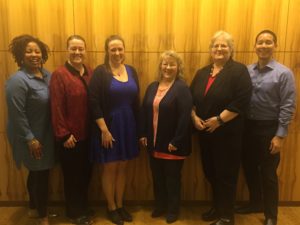 It’s a new year for the Seattle chapter. The 2017-2018 Board of Directors was installed May 18. Presiding over the installation ceremony was Tom Marseille, PE, Hon. AIA, LEED Fellow, of WSP USA.
It’s a new year for the Seattle chapter. The 2017-2018 Board of Directors was installed May 18. Presiding over the installation ceremony was Tom Marseille, PE, Hon. AIA, LEED Fellow, of WSP USA.
Pictured, left to right: Director Laiisha Thomas (MG2); Past President/Director Carrie Thompson, CDFA (Studio Meng Strazzara); Director EB Meyer (Weinstein A+U); President-elect Carol Wanda Spradlin (WSP USA); President Judy Beebe, CDFA (WSP USA); Treasurer Kurt Wong, CDFA (Studio Meng Strazzara). Not pictured: Vice President Crystal Ray (Pennell Consulting, Inc.); Secretary Jim Gregson (Parker Smith & Feek); and Director Gretchen Renz, CDFA (Bernardo|Wills Architects).
Sticky-back White Boards
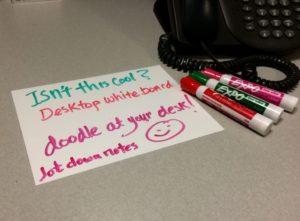 Have you seen them? You can peel and stick a dry erase white board just about anywhere. At EDSymposium17 in Minneapolis, one of the vendors was Business Essentials, provider of office supplies. We walked away with a sample of the sticky-back white board. What an awesome thing to have handy at your desk (you know, when you don’t have your own office that comes with its own white board).
Have you seen them? You can peel and stick a dry erase white board just about anywhere. At EDSymposium17 in Minneapolis, one of the vendors was Business Essentials, provider of office supplies. We walked away with a sample of the sticky-back white board. What an awesome thing to have handy at your desk (you know, when you don’t have your own office that comes with its own white board).
Just peel off the back and stick on your desk . . . instant white board! Grab some of the dry erase markers from the supply room or conference room and you have your own erase-it-when-you-want canvas.
EDSymposium17: education, networking, and more
Education. Networking. Raffle tickets. Business partners. Group activities. Humor (check out the name tags!).
That’s just some of what you get when you attend an SDA EDSymposium. This year it’s in Minneapolis/St. Paul, and OMG . . . you couldn’t ask for better weather! (There’s also a ton of construction going on—big time—right in front of the conference hotel; it’s the Nicollet Project, a revitalization of Minneapolis’ main street. But it’s cool; you just watch your step and follow the detours, and use the Skywalks to get to where you’re going.)
So what are Seattle chapter members Carol Spradlin, Carrie Thompson, Shannon Soady, Stacy Rowland, Gretchen Renz, and Judy Beebe doing in Minneapolis?
They are soaking up the education (so far, sessions on workplace ethics; ownership transition; the marketer and firm administrator; design risk; cyber challenges, and an NCARB session.) They are meeting other members from across the county and Canada. They are visiting the SDA business partners during the breaks (and picking up some awesome swag). They are buying raffle tickets to support the Past Presidents’ Council’s efforts to raise funds for EDSymposium grants. They are going to the Friday Night Dinner Rounds.
And then there’s Saturday to wrap things up: two educational sessions, a bus tour, the Annual Meeting, and the Awards Banquet.
At the Awards Banquet, the location for EDSymposium18 will be announced . . . and before you know it, Seattle chapter members will be gearing up for another great educational event by SDA national.
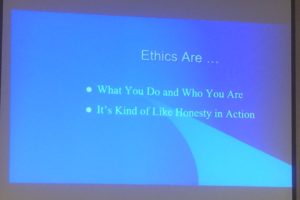

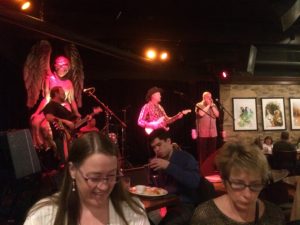
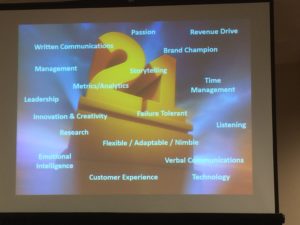
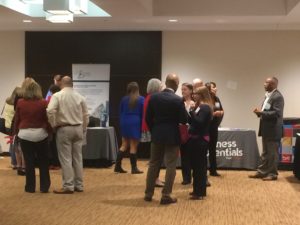
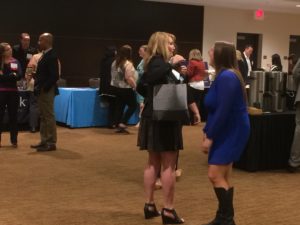
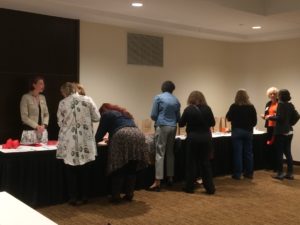
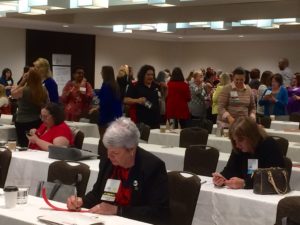
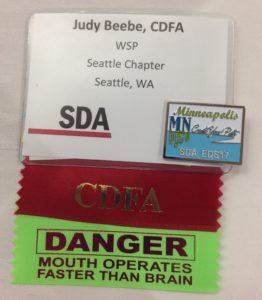
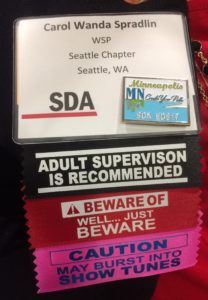
Please, for the love of chimichangas . . .
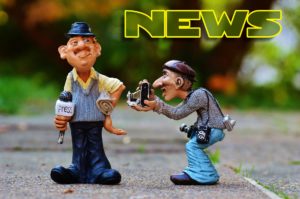 make sure you print, proofread, edit, then repeat.
make sure you print, proofread, edit, then repeat.
That’s what we heard from Tammy York (LandShark Communications LLC) in her webinar “How to Get Media Coverage for Your Firm (Press Release 101).”
York has a ton of tips on how to make it easy for a reporter, editor, or influencer to work with you, to “make it easy for them to choose you over the other 947 press releases they received this MORNING!”
And, whether you love chimichangas or not, one thing you want to do is to make sure your press release contains everything you want it to contain to get your announcement, event, promotion, or product published. That means no typos, no fancy fonts, no platitudes, and no clichés. It means thoroughly vetting the 6Ws of a press release: who, what, when, where, why, and how.
So whether you are the copywriter or you’ve hired someone outside the firm to fill that role—be sure you proofread, edit, then repeat—before sending out your press releases.
Have you hugged your coworker today?
 If you’re in the habit of wanting hugs from your coworkers, or you know someone who is an office-hugger, you should read an article written by Aaron Goldstein (partner at Dorsey & Whitney LLP). It talks about how the Ninth Circuit ruled that hugging can create a hostile work environment. Also in the article are links to recent information from the Equal Employment Opportunity Commission (EEOC) about workplace civility training.
If you’re in the habit of wanting hugs from your coworkers, or you know someone who is an office-hugger, you should read an article written by Aaron Goldstein (partner at Dorsey & Whitney LLP). It talks about how the Ninth Circuit ruled that hugging can create a hostile work environment. Also in the article are links to recent information from the Equal Employment Opportunity Commission (EEOC) about workplace civility training.
Here’s the article.
Own the room as a presenter: Tip #3
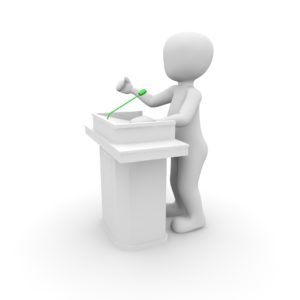 Carla Thompson generated a lot of discussion when she spoke to us about owning the room and not letting the fear of public speaking hold us back from . . . you got it—speaking in public.
Carla Thompson generated a lot of discussion when she spoke to us about owning the room and not letting the fear of public speaking hold us back from . . . you got it—speaking in public.
She shared 9 tricks and tips that can definitely help someone own the room as a presenter, and as a result, be a better, well-prepared public speaker.
It’s not enough just to know the words you are going to speak by heart. (Well, maybe memorization will help if all you have to do is speak from a lectern.) But what if, for example, you were told there is no lectern for you to hide behind? Do you know what you’ll do once you get to the room, knowing there won’t be the one piece of furniture/prop that you hoped there would be?
Carla’s Tip #3: Own the Space
Own the space means that you need to know, ahead of time:
- The layout of the space
- The lighting in the space
- The audio/visual equipment that will be used
- The acoustics of the space
If there’s no lectern, check to see if there’s a table for you to place your notes. If you like to move around while speaking, is there enough space in the room for you to do that, or will you have to watch where you step?
If you know whether the room lighting is bright or on the dark side, you’ll know whether you need a dark or light background on your PowerPoint slides.
If you’re using an unfamiliar laptop or a laptop for the first time, do you know how to show only your slides to your audience and be able to see your speaker notes on the laptop? Do you know how to use the remote to advance your slides?
Will you need a microphone, or is the room small enough for your voice to be heard?
Owning the space means you control your presence during your presentation.
So the next time you find yourself having to speak in front of a group, make sure you have a handle on the space that you’re going to be using during your presentation. If you’re comfortable in the space, it will help you be more comfortable speaking in front of others.
IRS lowers standard mileage rates for 2017
Effective January 1, 2017, the standard mileage rates for the use of a car (also vans, pickups or panel trucks) is:
- 53.5 cents per mile for business miles driven (down from 54 cents for 2016)
- 17 cents per mile driven for medical or moving purposes (down from 19 cents for 2016)
- 14 cents per mile driven in service of charitable organizations (unchanged from 2016)
No Notes Allowed!
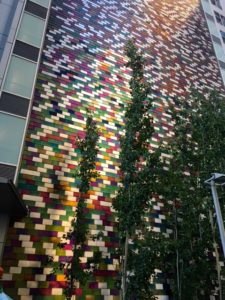
We hosted a reserved-only-for-us architectural walking tour in downtown Seattle, and one of the “tourists” was chapter member Carol Wanda Spradlin. We asked her to share a little bit with us, and this is what she said:
No, I did not take notes. How could I take notes when I was so busy looking and listening? By not focusing on capturing notes, I was enthralled in some visually-interesting, architecturally-cool info. You can’t experience that by trying to take notes.
So, hands-free (other than snapping pics), I’ll share these visuals with you:
- The terra cotta reliefs on the Cobb Building are NOT Chief Seattle or a compilation of all the tribes here in Washington. The reliefs were ordered out of a catalog from a company back east. The designer (or builder) looked in a catalog and ordered 10 Indian reliefs. The artist who designed the reliefs just put a bit of this with a bit of that and VOILA, Indian Chief (of course now it’s “Native American Chief”). There are 8 reliefs on the building, and one in the concourse between 4th Avenue and the One Union Square building. You can walk up to it and touch it. It’s very tall—very, very tall. (Okay, it’s a bit taller than me!) The 10th relief is in the Convention Center (I think).
- I didn’t take any notes because my focus was on looking around at things I hadn’t noticed before. Like: Little streams of water. The south face of a building that has multi-colored aluminum rectangles that are oh so beautiful (the 5th & Madison Condominiums—very upscale/high end). The side of the “pencil” building that is tiny little tiles . . . and I never noticed that before. I also didn’t know some people refer to the Rainier Tower as the pencil building, because, duh, it looks like a pencil standing on its point.
- In the downtown library, there is one corner just by the door that has five structural beams coming together at one point. It’s very unique.
- Did you know the Seattle Tower building has metal trees on top? From afar, they look like tiny, thin towers. Nope. They are trees. For decoration. And the building has white tiles at the top of each outside level to resemble . . . snow (on top of mountains). How cool is that?
Our Seattle Architecture Foundation tour guide, Garrett Lumens (of CallisonRTKL), was an absolute delight. It was a really interesting tour, and I hope the chapter hosts another one soon!
Thanks for sharing, Carol (and for the photo for this blog post); and thank you, Garrett, for leading the tour!
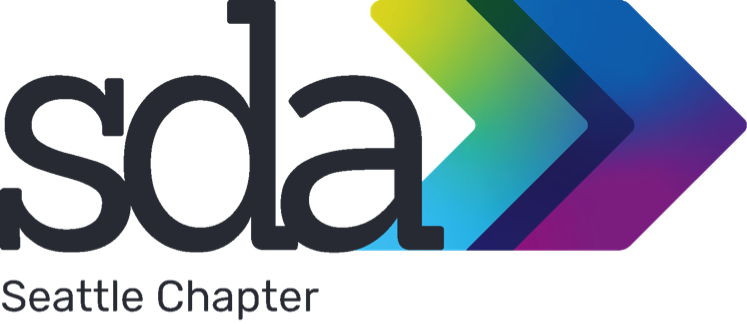



You must be logged in to post a comment.